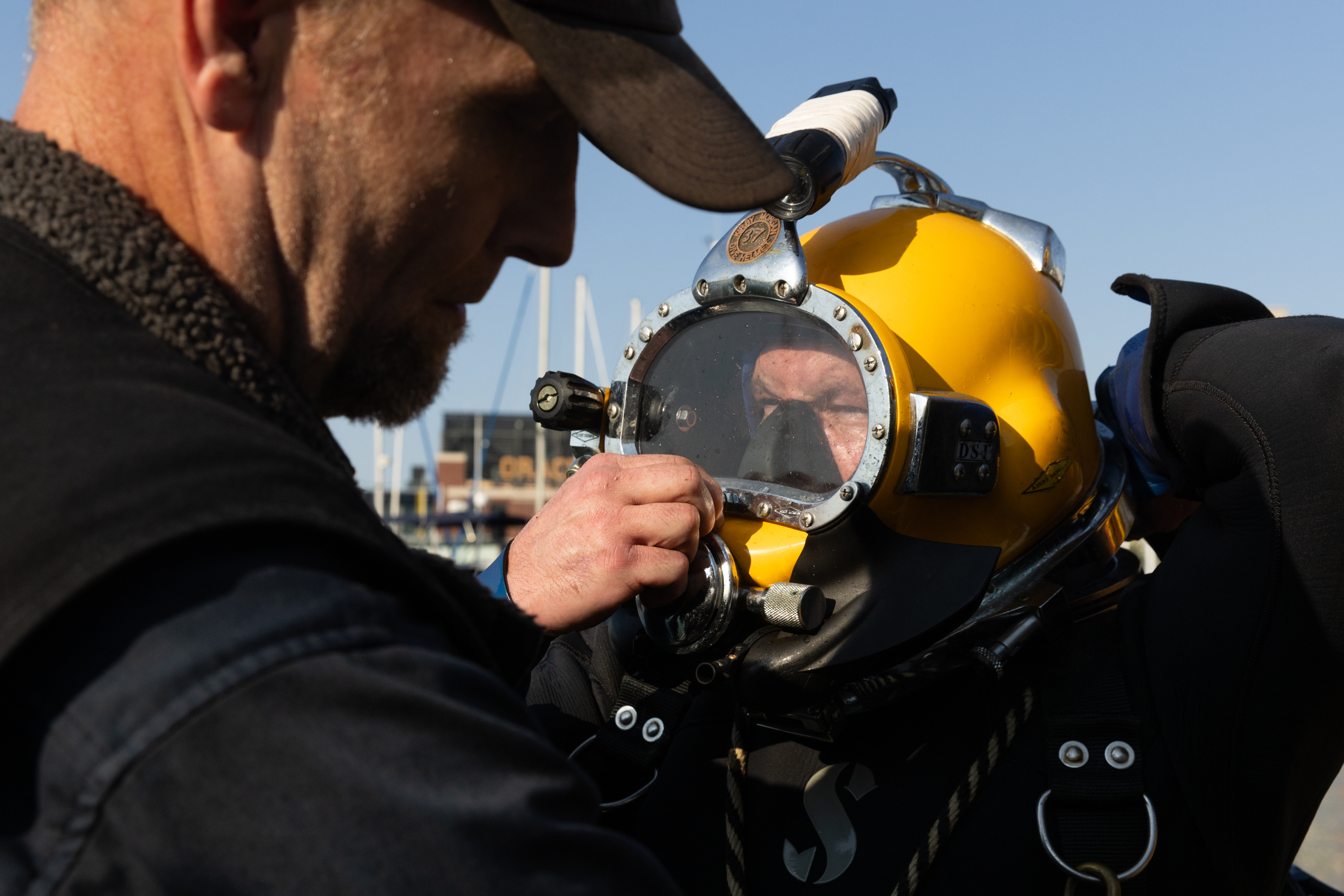Drew McEwing’s team needed to dive into frigid water and tunnel into the muddy floor of the San Francisco Bay to rescue a sunken barge.
Corrosion had worn holes into the old ship’s deck, and on one unlucky day, the current likely pushed the boat below Pier 70 during low tide. As the tide rose, the barge was pinned below the pier, allowing water to rush in through the deck holes, sending the vessel to the bay floor.
The barge represented a hidden threat, sitting just below the waves at high tide, putting ships approaching the pier at risk of hitting it.
After a pier worker spied the tip of the sunken ship sticking out of the surface, McEwing’s crew was called in one day in February 2022. He leads the Port of San Francisco dive team, a three-person squad that deploys along the city’s coastline to reinforce aging piers, cut down abandoned docks and, occasionally, haul wrecks from the seafloor.
McEwing and his crew dove into the water and with a giant vacuum-like tube slung over their shoulders, they burrowed into the mud where the barge had settled. As they went, they pulled straps around the wounded vessel so a crane could haul it to the surface.
“In this job, you’ll find yourself in some bizarre-like yoga positions, where you’re trying to hold your foot down into the mud so the current isn’t pushing you away,” McEwing recalled about the mission on a recent Wednesday. “You’re fighting currents, you’re fighting no visibility and it can be very claustrophobic.”
It was a hazardous job, but seeing the barge floating at the end was a good feeling, McEwing said.
The three divers on McEwing’s team are tasked with the daunting job of maintaining the city’s port infrastructure, much of which was built nearly a century ago. In the past year, record-breaking storms have combined with the ocean’s relentless battering to break pilings, destroy piers and even send trees floating into the bay. The debris from these major storms, like the one that struck last March, have created hazards for ferries and other vessels, and left the dive team hustling to clean up the mess.
“We’re only a three-man crew, so we do what we can to extend the life of [the piers] as much as possible,” McEwing said.
A Day on the Tuff Boat
On a recent Wednesday morning, Larry Derrington prepared for a dive off the team’s vessel, Tuff Boat, while floating in San Francisco’s South Beach Harbor, sandwiched between Oracle Park to the south and the Bay Bridge to the north. Already wearing a thick semi-dry wetsuit, beads of sweat broke out on Derrington’s forehead.
The mission of the day: Replace the zinc blocks attached to the I-beam columns holding up the pier adjacent to the harbor. The zinc blocks absorb the electrical currents in the bay, which cause metal to corrode. That way, the zinc blocks corrode, leaving the structurally important steel I-beams intact.
Once Derrington strapped on his bright yellow 35-pound helmet, flashlight affixed on top, he quickly splashed into the water, fins in hand. A hissing supply of oxygen flowed from Tuff Boat through an airline and into his helmet.
Derrington, 40, began diving as a teenager, and the profession took him around the world. He recalled working on dives down to the Costa Concordia, a luxury cruise liner that capsized off the Italian coast in 2012, killing 32 people. In Saudi Arabia, he dove deep below the surface of the Persian Gulf to cap abandoned oil wells, he explained.
These days, he lives in Sonoma, where he grew up.
“After you experienced an adventure and all that then you got to start thinking about the next thing in your life, and that’s family,” Derrington said. “If you want to pop out kids, you’ve got to be around.”
Replacing the zinc blocks in the protected harbor made for straightforward work. But the job isn’t always so worry-free. Other gigs require using underwater chainsaws and drills—power tools that could easily slice a diver’s airline. To make matters worse, the submerged worker oftentimes can’t even see where their airline snaking back to the boat is floating.
“You land on bottom, and all of a sudden, the mud cloud goes ‘whoosh,’ and it’s pitch black,” McEwing explained. “So you get used to using your hands as eyes.”
“So my family was like, ‘No, don’t go be a diver. It’s the dumbest thing you could do,’” Ryan Dunbar, the third member of the crew, said. But 20 years into the job, he said his mother, who expressed the most concern at first, has mostly found a way to feel comfortable with his hazardous profession.
Dunbar acted as Derrington’s “tender,” tending to his needs from topside. He knew the risks of diving before getting into the profession. His great-uncle was a commercial diver who died on the job, he said. While the details of the incident are murky, Dunbar said his great-uncle was working on a dam when he was fatally sucked up into a discharge pipe.
A collection of bubbles gathered on the surface of the water, slowly moving down the pier, marking Derrington’s progress as he replaced the worn-down zinc blocks one-by-one.
It was a routine day for the dive team, maintaining just one of the dozens of piers lining San Francisco’s miles-long waterfront. The work never ends.
Many of the piers were built in the 1930s and ’40s, McEwing explained.
“The abuse these [piers] take is just nonstop, 24/7,” McEwing said. “Salt water, currents, swells—it’s just a recipe to break stuff in the water.”
